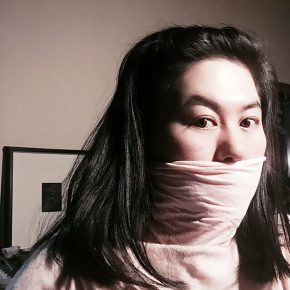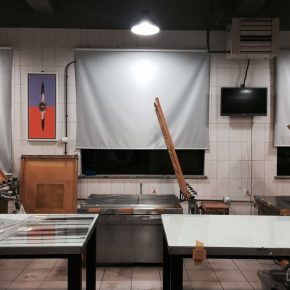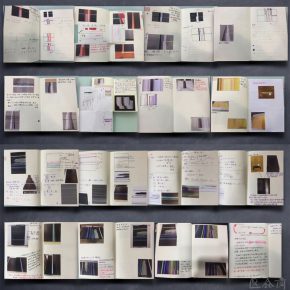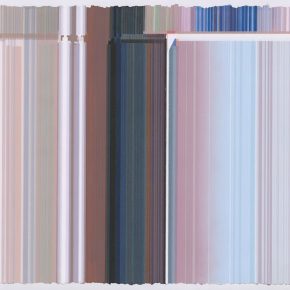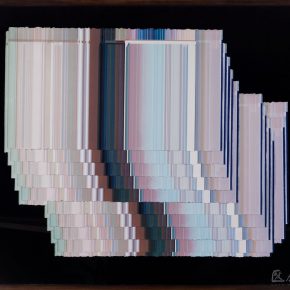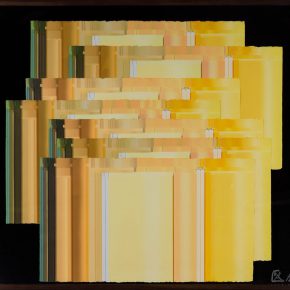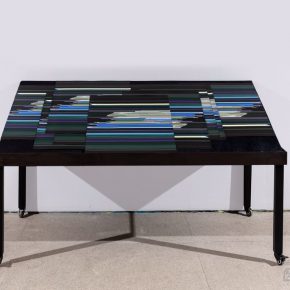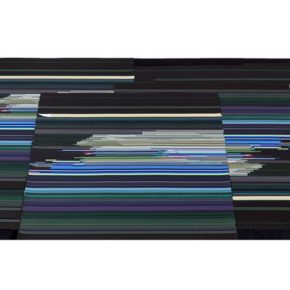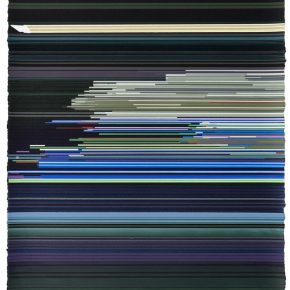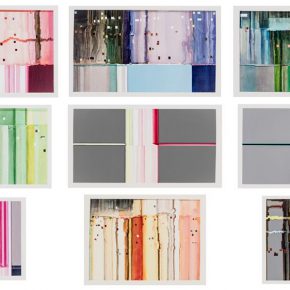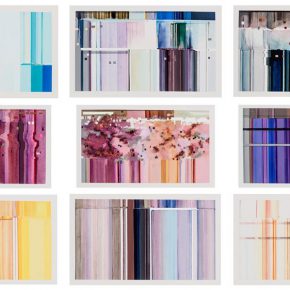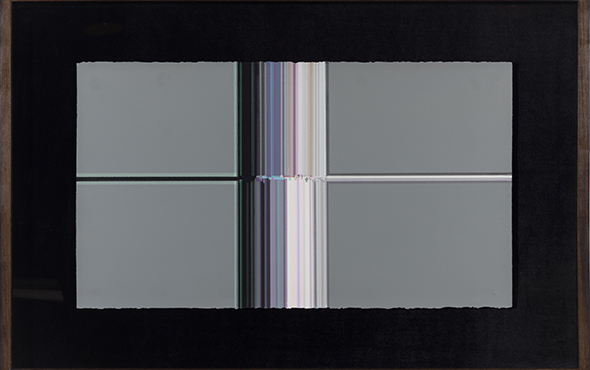
When I first saw the art of Su Rina in the Graduation Exhibition of graduates’ works in 2017, the disorderly vision gave people a dazzling sense, and the damages to a complete picture and order also brought psychological anxiety to the audience. Graduated from the Department of Printmaking, Su Rina simulates and reproduces the glitch of a screen in the form of screen prints, in order to discuss the expression of “glitch art” through printmaking, to find the internal game and balance in the “control” and “uncontrollable” creative process, while also exploring the study of color in the prints.
Interview Time: May 30, 2017
Interviewee: Su Rina
Interviewer and copywriter: Zhang Wenzhi
Translated by Chen Peihua and edited by Sue/CAFA ART INFO
The display of the glitch of electronic equipment is familiar to us in this era with exposure to the media and the display glitches brought by the computer viruses or machinery failure, produce situations that people are reluctant to face, but it is a class of artists and art style that prefer this destructive, subversive visual state and create a creative form called the “Glitch Art”. Glitch art was originally regarded as having an erroneous aesthetic attitude, a critical aesthetic idea combined with all kinds of flaws, attempting the pursuit of re-creation after breaking routines by “accident” or “change”. Nam June Paik once placed a large magnet on a television set, which transforms the TV signal into an abstract composition, and it gives the display a sculptural character in the process and interferes with standardized programs and functions.
Su Rina is interested in “Glitch Art”, which is not because she is engaged in the work of video and photography, multimedia but because she was absorbed in the painting of the stage for the undergraduate study, with the artistic practice of an easel concept, but she was a young person who loved culture and arts, liked to listen to some niche music and the popular cracked discs became her favorites, because the existence of the crack led to the damaging of part of the music, for example, the sound will drag on very long. The earlier popular video tapes also caused a splash screen because of the exorbitant play which also inspired her to pay attention to “glitch” in future art creation. Su Rina graduated from the School of Urban Design, CAFA, and then married, as she said that she had been an artistic housewife for 6 years, and influenced by her husband who also graduated from the Department of Printmaking, CAFA, she was also interested in printmaking, in addition to searching for a point that is suitable for her again in life and art, so she entered the Department of Printmaking for further study.
After entered the Department of Printmaking, Su Rina really connected with prints for the first time, and when she recalled that she really experienced a difficult but interesting process of growing. Her research direction was “the research on printmaking color”, using a clumsy way to be familiar with the creative mode of printmaking and color perception, to copy a mural painting from the Kizil Grottoes. The color on the palette is slightly different from the color of the screen prints and this color mixing can’t be quantified by the data, and she could only search for the sensation through constant practice. Su’s first print took two months to complete, which did not only win the tutors’ affirmation but also helped her to find the doorway to the color of the prints. The color is the clue running through Su’s creation, and when people ask her how many versions of this work do you have, Su Rina laughed and said that there was not a concept of “version”, but it was a concept of quantity of colors.
Although the “Glitch Art” and the multimedia display have a relationship which is similar to blood relatives, Su Rina thought that this critical aesthetic phenomenon should not be locked in the framework of multimedia, and the glitch art had an uncontrollable unique quality, we see the visual image which is a short-term freeze-frame, Su combines screen prints and glitch art, and also tries to use the pluralism of prints to combat this unity. From the glitch to glitch art, the glitch which randomly happened at first was turned to into a controllable presentation for the artist to grasp the structure of the screen, which overturns the generation of mechanism of imaging in the premise of maintaining the uniformity of visual language. The form of Su Rina’s screen prints simulate the effect of “glitch art”, the use of the control and uncontrollable in the process of producing screen prints, challenging the control of the “glitch art”, while challenging the machinery glitches to form the glitch images because it is impossible to win. The whole process of creation is the internal game and balance between the “controllable” and “uncontrollable”, and finally performing the convergence of the image ofscreen.
Of course, in the creation of the graduation work of “Beauty • Madness • Chaos”, color research is also carried out simultaneously. Su Rina set hundreds or evenmore color bars, overlapping to create more colors, becoming more complicated and orderly, making it the container that accommodates the light and time. Because of the glitch, the characteristic of the image color is the result of randomly generating without modification, its color principle is the luminous color (RGB mode), which is different from the color seen in reality, and it is referred to as the “digital color”. In the long-term study, she simulated “digital colors” on the paper, and also summed up a set of rules, for example, the use of “medium” to increase the brightness of part of the color; the use of “transparent gel” to increase the thickness, dispersing the density particles of color, in order to achieve the effect of saving the light; through the multi-color gradient to gently make the color transit; adjusting the color density, relying on changes of different transparencies that are superimposed to achieve the presupposed effect.


